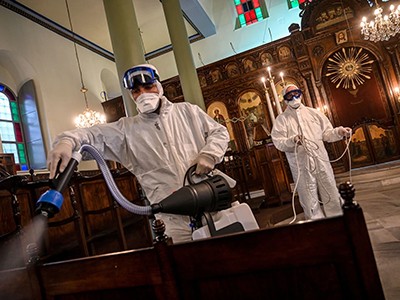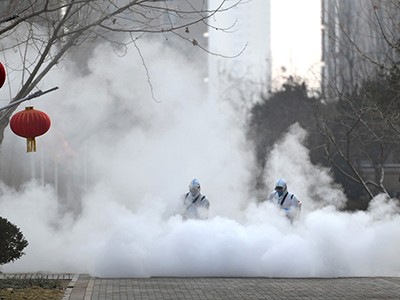[ad_1]
The World Health Organization (WHO) has changed how it classifies pathogens that spread through the air, such as SARS-CoV-2. The redefinition has been two years in the making and comes after criticism that during the COVID-19 pandemic, the WHO was too slow to acknowledge that COVID was airborne. The change aims to provide clarity during pandemics, but some researchers are not convinced.
Virologists now acknowledge that SARS-CoV-2 spreads mostly by airborne transmission of small particles that are inhaled and that can remain in the air for hours — a method that was previously called ‘aerosol’ transmission. It also spreads by larger ‘droplets’ of virus-containing particles on surfaces, including hands, or ejected over short distances.
Why the WHO took two years to say COVID is airborne
However WHO didn’t publicly acknowledge the importance of airborne transmission until October 2020, a decision that outgoing chief scientist Soumya Swaminathan said in November 2022 said should have been made much earlier based on the available evidence. It didn’t amend its official document on COVID-19 transmission to include airborne transmission until December 2021. As a result, early infection control and prevention advice focused mainly on surface cleaning, hand-washing and social distancing, rather than mask-wearing and improved ventilation.
Some researchers say earlier recognition of airborne transmission by the WHO could have saved lives, noting mounting evidence that pointed to airborne transmission before its official acknowledgement.
Technical report
To clarify the distinction between airborne, droplet and aerosol, the WHO released a technical report on 18 April after more than two years of consultation with more than 100 experts from a range of scientific disciplines. The report does away with the division between ‘droplets’ and ‘aerosols’ used during the pandemic to distinguish between particles above or below five micrometres in diameter. Instead, it proposes the term ‘infectious respiratory particles’ to describe all such particles, regardless of size.
However the report still shies away from describing all pathogens that spread through the air as ‘airborne’. Instead, the document uses the umbrella term ‘through the air’ to describe any mode of transmission that “involves the pathogen travelling through or being suspended in the air”. That is then further broken down into two categories: ‘airborne transmission/inhalation’ is when infectious respiratory particles are inhaled from the air into the respiratory tract; while ‘direct deposition’ is when those particles travel over short range to land directly on the mouth, nose or eyes of another person.
Under this terminology, COVID-19 would be recognized as spreading through the air by airborne/inhalation transmission, with a much smaller risk of transmission by direct deposition.
Up in the air
It’s a mixed result for many scientists. “The positive thing which I see of this report is the fact that the report removes this division of five micrometres between aerosols and droplets,” says Lidia Morawska, an aerosol scientist at the Queensland University of Technology in Brisbane, Australia. That distinction was the justification for emphasis on hand-washing, distancing and surface-cleaning, rather than mask-wearing and ventilation — a distinction Morawska says was unscientific. It was also the distinction that justified WHO’s March 2020 assertion that COVID-19 was not airborne.
But that achievement of the report has been tarnished for some by the classification of ‘through the air’, instead of airborne.
“The simplest and clearest way to describe it is to call it airborne transmission,” says Linsey Marr, environmental engineer at Virginia Tech in Blacksburg, United States, whose research focuses on the transmission of infectious disease via aerosols and who was involved in the report. “We talk about waterborne transmission, blood-borne transmission, vector-borne transmission; it seems very logical and simple to me that we would call this airborne transmission.”
WHO Chief Scientist Jeremy Farrar says ‘through the air’ allows for recognition of both airborne transmission in which infectious respiratory particles are inhaled, and the less common transmission via direct deposition. “It’s not a dichotomy of mutually exclusive transmission routes,” he says. The recognition of both ‘airborne’ and ‘direct deposition’ under the umbrella of ‘through the air’ avoided going back to the divide between aerosols and droplets, Farrar says. ‘Through the air’ is comparable with vector-borne and waterborne, he says, but acknowledges that “there is a direct deposition element, even if that is not the major way it transmits.”
Julian Tang, a clinical virologist at the University of Leicester, UK, who was also involved with the report, says there was vigorous debate among experts about the term airborne and what it conveys. Some of the scientists on the team that prepared the report argued that it would be problematic to use ‘airborne’ for all pathogens that spread through the air. “They think it’s too scary, too frightening, has too many connotations and it will cause panic, so they chose ‘through the air’,” Tang says.
Farrar says he has no reticence to use the term ‘airborne’. He stresses that this technical report is merely the ‘base camp’ of an ongoing process to refine terminology and its practical applications. “I’m not saying everybody is happy, and not everybody agrees on every word in the document, but at least people have agreed this is a baseline terminology.”
But Morawska, who also consulted on the report, argues that division between airborne and direct deposition is not justified. “It is just confusing the issues,” she says.
Even the co-chair of the group that developed the document, environmental engineer Yuguo Li from the University of Hong Kong, says he prefers the term ‘airborne’ to ‘through the air’. However, he says what’s important is how the concept is applied in practice. “In theory, airborne is a perfect umbrella term as waterborne and vector-borne, but it means different things to different people,” Li says. “The issue is not only about terminologies, it’s about the need to work with public health experts, medical experts to understand those responses.”
COVID-19 rarely spreads through surfaces. So why are we still deep cleaning?
Tang says the document sets an important benchmark for how the world responds to the next pandemic. “The next pandemic will most likely be a respiratory virus again because that’s normally the pathogen that mutates the fastest,” he says. The report’s clarity around transmission will help public health providers to respond appropriately. “They will then consider masking early, they’ll consider ventilation early, they’ll consider all these precautions early because a precedent has been set already.”
The report notes that measures to address through-the-air transmission must take into account both the risk posed by the infection itself — for example, disease severity — and the resources available, which may be limited in low or middle-income countries.
Farrar believes this new definition could save lives in future pandemics. “What’s needed now is moving on from base camp to now understanding actually, the non-pharmacological interventions that really matter, and if they work, and the evidence of it.”
[ad_2]
Source Article Link



